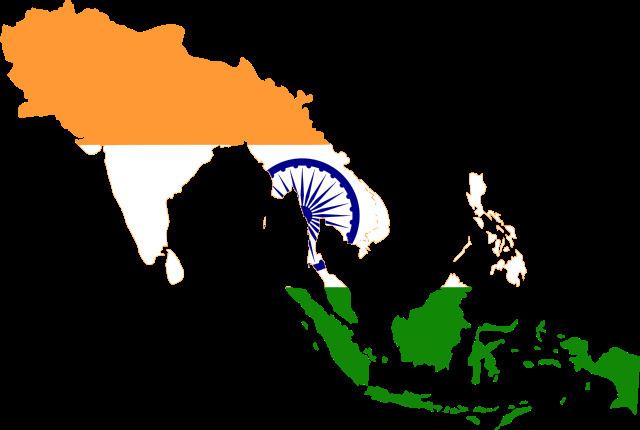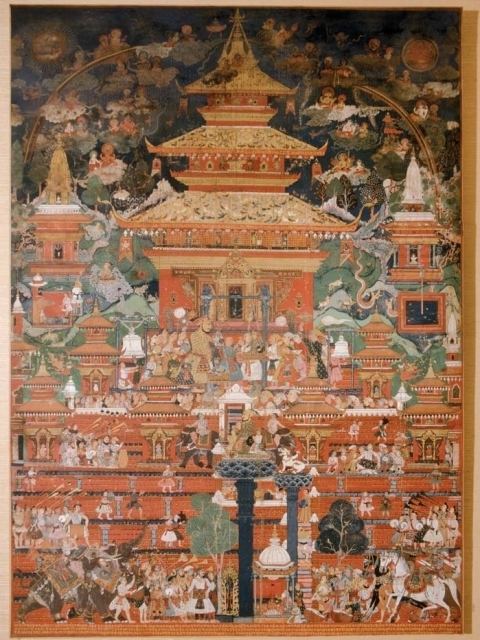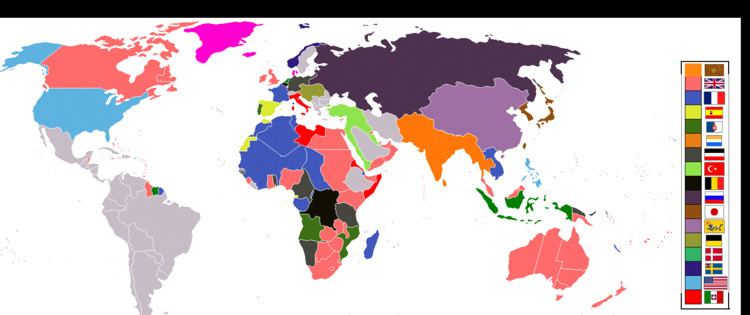 | ||
Indianized kingdomsHinduismArchitectureEpigraphy Butuan, Champa, Dvaravati, Funan, Gangga Negara, Chenla, Kalingga, Kutai, Langkasuka, Pagan, Pan Pan, Tondodevaraja, HariharaAngkor, BorobodurSanskrit, Pali Buddhism Bangladesh, Bhutan, Nepal, Sri Lanka Hinduism Bangladesh, Bhutan, Nepal, Pakistan, Sri Lanka Buddhism China, Japan, Korea, Mongolia, Tibet Buddhist monasticism Central Asia (Afghanistan · Uzbekistan) Similar Indus River, Hindu Kush, Indian subcontinent | ||
The term Greater India is most commonly used to encompass the historical and geographic extent of all political entities of the Indian subcontinent and beyond, that had to varying degrees been transformed by the acceptance and induction of cultural and institutional elements of pre-Islamic India. Since around 500 B.C. Asia's expanding land and maritime trade had resulted in prolonged socio-economic and cultural stimulation and diffusion of Hindu and Buddhist beliefs into regional cosmology, in particular in Southeast Asia and Sri Lanka. In Central Asia transmission of ideas were predominantly of religious nature.
Contents
- Greater india
- European designations
- Geology
- Nationalist movement
- Indianised kingdoms
- Hinduism authority and legitimacy
- Adaption and adoption
- Individual mainland kingdoms
- Individual island kingdoms
- Indosphere
- Cultural sphere
- Cultural expansion
- Literature
- Shared traditions
- Religion mythology and folklore
- Architecture and monuments
- Linguistic influence
- Linguistic commonalities
- Toponyms
- References

By the early centuries of the common era most of the principalities of maritime and continental Southeast Asia had effectively absorbed defining aspects of Hindu culture, religion and administration. The notion of divine god-kingship was introduced by submission to the concept of Harihara, Sanskrit and other Indian epigraphic systems declared official like those of the south Indian Pallava dynasty and Chalukya dynasty. These Indianized Kingdoms, a term coined by George Cœdès were characterized by surprising resilience, political integrity and administrative stability.

To the north Indian religious ideas dissipated into the cosmology of Himalayan peoples, most profoundly in Tibet and Bhutan. Buddhist monasticism extended into Afghanistan, Uzbekistan and other parts of Central Asia and Buddhist texts and ideas successfully reached China and Japan in the east. Unlike Southeast Asia cultural and technological stimulation in East Asia always went in both directions. To the west, Indian culture converges with Greater Persia via the Hindukush and the Pamir Mountains.

Greater india
European designations

The concept of the Three Indias was in common circulation In pre-industrial Europe. Greater India was the southern part of South Asia, Lesser India was the northern part of South Asia, and Middle India was the region near the Middle East. The Portuguese form (Portuguese: India Maior) was used at least since the mid-15th century. The term, which seems to have been used with variable precision, sometimes meant only the Indian subcontinent; Europeans used a variety of terms related to South Asia to designate the South Asian peninsula, including High India, Greater India, Exterior India and India aquosa.
However, in some accounts of European nautical voyages, Greater India (or India Major) extended from the Malabar Coast (present-day Kerala) to India extra Gangem (lit. "India, beyond the Ganges," but usually the East Indies, i.e. present-day Malay Archipelago) and India Minor, from Malabar to Sind. Farther India was sometimes used to cover all of modern Southeast Asia and sometimes only the mainland portion. Until the fourtheenth century, India could also mean areas along the Red Sea, including Somalia, South Arabia, and Ethiopia (e.g., Diodorus of Sicily of the first century BCE says that "the Nile rises in India" and Marco Polo of the fourteenth century says that "Lesser India ... contains ... Abash [Abyssinia]")
In late 19th-century geography Greater India referred to British India, Hindustan (Northwestern Subcontinent) which included the Punjab, the Himalayas, and extended eastwards to Indochina (including Burma), parts of Indonesia (namely, the Sunda Islands, Borneo and Celebes), and the Philippines." German atlases distinguished Vorder-Indien (Anterior India) as the South Asian peninsula and Hinter-Indien as Southeast Asia.
Geology
Greater India, or Greater India Basin signifies "the Indian Plate plus a postulated northern extension", the product of the Indian–Asia collision. Although its usage in geology pre-dates Plate tectonic theory, the term has seen increased usage since the 1970s.
The hypothesis is legitimate as long as the controversy of the location and time of the India-Asia convergence exists. How and where the India–Asia (Indian and Eurasian Plate) convergence was accommodated, after the collision, at or before 52 Million years ago? Since the plates have converged up to 3,600 km (2,200 mi) ± 35 km (22 mi), yet the upper crustal shortening documented from the geological record of Asia and the Himalaya is up to approximately 2,350 km (1,460 mi) less.
Nationalist movement
The use of Greater India refers here to a popularization by a network of Bengali scholars in the 1920s who were all members of the Calcutta-based Greater India Society. The movement's early leaders included the historian R. C. Majumdar (1888–1980); the philologists Suniti Kumar Chatterji (1890–1977) and P. C. Bagchi (1898–1956) and the historians Phanindranath Bose and Kalidas Nag (1891–1966).
The term Greater India and the notion of an explicit Hindu colonization of ancient Southeast Asia have been linked to both Indian nationalism and Hindu nationalism.
Indianised kingdoms
The concept of the Indianized kingdoms, a term coined by George Coedès, describes maritime and continental Southeast Asian principalities that since the early common era as a result of centuries of socio-economic interaction had incorporated central aspects of Indian institutions, religion, statecraft, administration, culture, epigraphy, writing and architecture.
Iron age trade expansion caused regional geostrategic remodeling. Southeast Asia was now situated in the central area of convergence of the Indian and the East Asian maritime trade routes, the basis for economic and cultural growth. The earliest Hindu kingdoms emerged in Sumatra and Java, followed by mainland polities such as Funan and Champa. Selective adoption of Indian civilization elements and individual suitable adaption stimulated the emergence of centralized states and development of highly organized societies. Ambitious local leaders realized the benefits of Hindu worship. Rule in accord with universal moral principles represented in the concept of the devaraja was more appealing than the Chinese concept of intermediaries.
The exact nature, process and extent of Indian influence upon the civilizations of the region is still fiercely debated by contemporary scholars. Debated are most claims over whether it was Indian merchants, brahmins, nobles or Southeast Asian mariner-merchants who played a central role in bringing Indian conceptions to Southeast Asia. Debated is the depth of the influence of traditions for the people. Whereas early 20th-century scholars emphasized the thorough Indianization of Southeast Asia, more recent authors argued that this influence was very limited and affected only a small section of the elite.
Hinduism, authority and legitimacy
The pre-Indic political and social systems in Southeast Asia were marked by a relative indifference towards lineage descent. Hindu god kingship enabled rulers to supersede loyalties, forge cosmopolitan polities and the worship of Shiva and Vishnu was combined with ancestor worship, so that Khmer, Javanese, and Cham rulers claimed semi-divine status as descendants of a god. Hindu traditions especially the relationship to the sacrality of the land and social structures indicates that Hinduism was characterized by transnational features. The epic traditions of the Mahābhārata and the Rāmāyaṇa further legitimized a ruler identified with a god who battled the demonic forces that threaten the ethical order of the world.
Hinduism does not have a single historical founder, a centralized imperial authority in India proper and a bureaucratic structure ensuring relative religious independence for the individual ruler. It also allows for multiple forms of divinity, centered upon the Trimurti the triad of Brahma, Visnu, and Siva, the deities responsible for the creation, preservation and destruction of the universe.
Butuan, Champa, Dvaravati, Funan, Gangga Negara, Kadaram, Kalingga, Kutai, Langkasuka, Pagan, Pan Pan, Po-ni, Tarumanagara and Tondo had by the 1st to 4th centuries CE. adopted Hindu cosmology, the devaraja concept of kingship, and Sanskrit as official writing. Despite the fundamental cultural integration, these kingdoms remained independent from the Indian mainland states.
Adaption and adoption
It is unknown how immigration, interaction and settlement took place, whether by key figures from India or through Southeast Asians visiting India who took elements of Indian culture back home. It is likely that Hindu and Buddhist traders, priests, and princes traveled to Southeast Asia from India in the first few centuries of the Common Era and eventually settled there. Strong impulse most certainly came from the region’s ruling classes who invited Brahmans to serve at their courts as priests, astrologers and advisers. Divinity and royalty were closely connected in these polities as Hindu rituals served to validate the powers of the monarch. Brahmans and priests from India proper played a key role in elevating ruling dynasties through exact rituals. Dynastic consolidation was the basis for more centralized kingdoms that emerged in Java, Sumatra, Cambodia, Burma, and along the central and south coasts of Vietnam during the 8th century.
Art, Architecture, rituals, and cultural elements such as the Rāmāyaṇa and the Mahābhārata had been adopted and customized increasingly developed a regional character. The caste system, although adopted was never applied universally and reduced to serve for a selected group of nobles only.
States such as Srivijaya, Majapahit and the Khmer empire with territorial continuity, resilient population and surplus economies soon rivaled those in India itself. Borobudur in Java and Angkor in Cambodia are, apart from their grandeur examples for a distinctly developed regional culture, style and expression.
Southeast Asia is called Suvarnabhumi or Sovannah Phoum - the golden land and Suvarnadvipa - the golden Islands in Sanskrit. It was frequented by traders from eastern India, particularly Kalinga. Cultural and trading relations between the powerful Chola dynasty of South India and the Southeast Asian Hindu kingdoms led the Bay of Bengal to be called "The Chola Lake", and the Chola attacks on Srivijaya in the 10th century CE are the sole example of military attacks by Indian rulers against Southeast Asia. The Pala dynasty of Bengal, which controlled the heartland of Buddhist India, maintained close economic, cultural and religious ties, particularly with Srivijaya.
Individual mainland kingdoms
Individual island kingdoms
Indosphere
The term Indosphere encompasses the full extent of Indian linguistic and cultural influence in Asia in a non-geographical sense. It is commonly used in areal linguistics in contrast with the Sinosphere.
Cultural sphere
The use of Greater India to refer to an Indian cultural sphere was popularised by a network of Bengali scholars in the 1920s who were all members of the Calcutta-based Greater India Society. The movement's early leaders included the historian R. C. Majumdar (1888–1980); the philologists Suniti Kumar Chatterji (1890–1977) and P. C. Bagchi (1898–1956), and the historians Phanindranath Bose and Kalidas Nag (1891–1966).
Some of their formulations were inspired by concurrent excavations in Angkor by French archaeologists and by the writings of French Indologist Sylvain Lévi. The scholars of the society postulated a benevolent ancient Indian cultural colonisation of Southeast Asia, in stark contrast—in their view—to the colonialism of the early 20th century.
The term Greater India and the notion of an explicit Hindu colonisation of ancient Southeast Asia have been linked to both Indian nationalism and Hindu nationalism. However, many Indian nationalists, like Jawaharlal Nehru and Rabindranath Tagore, although receptive to "an idealisation of India as a benign and uncoercive world civiliser and font of global enlightenment," stayed away from explicit "Greater India" formulations. In addition, some scholars have seen the Hindu/Buddhist acculturation in ancient Southeast Asia as "a single cultural process in which Southeast Asia was the matrix and South Asia the mediatrix." In the field of art history, especially in American writings, the term survived longer due to the influence of art theorist Ananda Coomaraswamy. Coomaraswamy's view of pan-Indian art history was influenced by the "Calcutta cultural nationalists."
By some accounts Greater India consists of "lands including Burma, Java, Cambodia, Bali, and the former Champa and Funan polities of present-day Vietnam," in which pre-Islamic Indian culture left an "imprint in the form of monuments, inscriptions and other traces of the historic "Indianising" process." By some other accounts, many Pacific societies and "most of the Buddhist world including Ceylon, Tibet, Central Asia, and even Japan were held to fall within this web of Indianising culture colonies" This particular usage—implying cultural "sphere of influence" of India—was promoted by the Greater India Society, formed by a group of Bengali men of letters, and is not found before the 1920s. The term Greater India was used in historical writing in India into the 1970s.
Cultural expansion
Culture spread via the trade routes that linked India with southern Burma, central and southern Siam, the Malay peninsula and Sumatra to Java, lower Cambodia and Champa.
The Pali and Sanskrit languages and the Indian script, together with Theravada and Mahayana Buddhism, Brahmanism and Hinduism, were transmitted from direct contact as well as through sacred texts and Indian literature.
Southeast Asia had developed some prosperous and very powerful colonial empires that contributed to Hindu-Buddhist artistic creations and architectural developments. Art and architectural creations that rivaled those built in India, especially in its sheer size, design and aesthetic achievements. The notable examples are Borobudur in Java and Angkor monuments in Cambodia. The Srivijaya Empire to the south and the Khmer Empire to the north competed for influence in the region.
A defining characteristic of the cultural link between Southeast Asia and the Indian subcontinent is the spread of ancient Indian Vedic/Hindu and Buddhist culture and philosophy into Myanmar, Thailand, Indonesia, Malaya, Laos and Cambodia. Indian scripts are found in Southeast Asian islands ranging from Sumatra, Java, Bali, south Sulawesi and most of the Philippines.
Literature
The Ramayana and the Mahabharata have had a large impact on the South Asia and Southeast Asia. However, the Mahabharata has faded from the memory of many Southeast Asian nations and are not as widely known as the Ramayana.
Shared traditions
One of the most tangible evidence of dharmic tradition commonality, probably is the widespread of Añjali Mudrā as the gesture of greeting and respect. It is demonstrated in Indian namasté, and similar gestures are known in Southeast Asia, as it cognate to the Cambodian sampeah, Indonesian sembah and Thai wai.
Religion, mythology and folklore
Architecture and monuments
Linguistic influence
Scholars like Sheldon Pollock have used the term Sanskrit Cosmopolis to describe the region, and argued for millennium-long cultural exchanges without necessarily involving migration of peoples or colonisation. Pollock's 2006 book The Language of the Gods in the World of Men makes a case for studying the region as comparable with Latin Europe and argues that the Sanskrit language was its unifying element.
Sanskrit and related languages have also influenced their Sino-Tibetan-speaking neighbours to the north through the spread of Buddhist texts in translation. Buddhism was spread to China by Mahayanist missionaries sent by Emperor Ashoka mostly through translations of Buddhist Hybrid Sanskrit and Classical Sanskrit texts, and many terms were transliterated directly and added to the Chinese vocabulary. The situation in Tibet is similar; many Sanskrit texts survive only in Tibetan translation (in the Tanjur).
In Southeast Asia, languages such as Thai and Lao contain many loan words from Sanskrit, as does Khmer to a lesser extent. For example, in Thai, Rāvaṇa, the legendary emperor of Sri Lanka, is called 'Thosakanth' which is derived from his Sanskrit name 'Daśakaṇṭha' ("having ten necks").
Many Sanskrit loanwords are also found in Austronesian languages, such as Javanese particularly the old form from which nearly half the vocabulary is derived from the language. Other Austronesian languages, such as traditional Malay, modern Indonesian, also derive much of their vocabulary from Sanskrit, albeit to a lesser extent, with a large proportion of words being derived from Arabic. Similarly, Philippine languages such as Tagalog have many Sanskrit loanwords.
A Sanskrit loanword encountered in many Southeast Asian languages is the word bhāṣā, or spoken language, which is used to mean language in general, for example bahasa in Malay, Indonesian and Tausug, basa in Javanese, Sundanese, and Balinese, phasa in Thai and Lao, bhasa in Burmese, and phiesa in Khmer.
